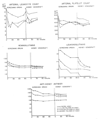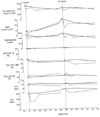Mechanism and modification of rejection of heterografts between divergent species
- PMID: 4939700
- PMCID: PMC2903835
Mechanism and modification of rejection of heterografts between divergent species
Abstract
This study was undertaken with several specific objectives: to evaluate the role of preformed heterospecific antibodies in causing hyperacute rejection of whole organs transplanted from dogs to pigs or pigs to dogs; to see how much this abrupt rejection could be mitigated by the antibody depletion that occurs with the use of successive organs; to establish the contribution of coagulation changes to the pathogenesis of this kind of hyperacute rejection; and to determine if there were similarities between abrupt heterograft rejection and hyperacute rejection of homografts in presensitized recipients.
Figures










References
-
- Welch CS. A note on transplantation of the whole liver in dogs. Transplantation Bull. 1955;2:54.
-
- Terasaki PI, McClelland JD. Micro-droplet assay of human serum cytotoxins. Nature. 1964;204:998. - PubMed
-
- Gold ER, Fudenberg HH. Chromic chloride: A coupling reagent for passive hemag-glutination reactions. J. Immun. 1967;99:859. - PubMed
MeSH terms
Substances
Grants and funding
LinkOut - more resources
Full Text Sources
Other Literature Sources
